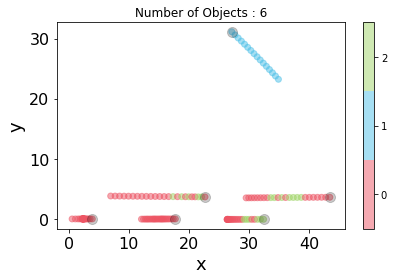In [1]:
1
2
3
4
5
6
7
8
9
import torch
import numpy as np
import matplotlib.pyplot as plt
from matplotlib.colors import ListedColormap
from hmmlearn.hmm import GaussianHMM
np.set_printoptions(precision=3, suppress=True)
%matplotlib inline
In [2]:
1
2
3
4
data_path = 'data/train.pt'
data = torch.load(data_path)
N, C, T, V = data.shape
data.shape
1
torch.Size([67718, 10, 24, 10])
In [3]:
1
2
3
4
N = 500
num_states = 3
data = data[np.random.choice(range(N), N)]
data.shape
1
torch.Size([500, 10, 24, 10])
In [4]:
1
2
3
4
5
num_objects = data[:,-1,-1].sum(1).numpy().astype(int)
X = torch.cat([data[i,:-1,:,:n].permute(2,1,0) for i, n in enumerate(num_objects)]).numpy() # N, T, C
L = np.array(X.shape[0] * [X.shape[1]])
X = X.reshape(-1, C-1)
X.shape, L
1
((41616, 9), array([24, 24, 24, ..., 24, 24, 24]))
In [5]:
1
2
3
trained_model = GaussianHMM(n_components=num_states, n_iter=N*10, verbose=True, tol=1e-10)
trained_model.fit(X, L)
1
2
3
4
5
6
7
8
9
10
11
12
13
14
15
16
17
18
19
20
21
22
23
24
25
26
27
28
29
30
31
32
33
34
35
36
37
38
39
40
41
42
43
44
45
46
47
48
49
50
51
1 -662674.4627 +nan
2 -612362.9883 +50311.4744
3 -527996.5661 +84366.4221
4 -386087.2248 +141909.3413
5 -288414.5388 +97672.6860
6 -249723.9687 +38690.5701
7 -197032.9378 +52691.0309
8 -167593.5663 +29439.3715
9 -161980.5326 +5613.0337
10 -156040.2651 +5940.2675
11 -151346.2949 +4693.9702
12 -148383.1823 +2963.1126
13 -146283.8510 +2099.3312
14 -144802.7061 +1481.1449
15 -144227.5810 +575.1252
16 -144008.0702 +219.5108
17 -143867.5950 +140.4751
18 -143758.8215 +108.7735
19 -143648.9633 +109.8583
20 -143540.6495 +108.3138
21 -143454.9027 +85.7468
22 -143385.5742 +69.3285
23 -143325.1282 +60.4460
24 -143281.5400 +43.5881
25 -143239.9319 +41.6081
26 -143223.1078 +16.8242
27 -143216.6505 +6.4573
28 -143211.7679 +4.8826
29 -143193.3477 +18.4202
30 -143106.4029 +86.9448
31 -142936.8979 +169.5049
32 -142763.5685 +173.3294
33 -142628.3667 +135.2018
34 -142565.2359 +63.1308
35 -142519.8133 +45.4226
36 -142380.2397 +139.5736
37 -141846.5114 +533.7283
38 -141551.8564 +294.6550
39 -141325.3312 +226.5252
40 -140950.6366 +374.6946
41 -140722.0542 +228.5824
42 -140282.7640 +439.2901
43 -138684.5387 +1598.2253
44 -135834.9579 +2849.5808
45 -135793.9120 +41.0458
46 -135778.4024 +15.5096
47 -135772.6509 +5.7515
48 -135770.8351 +1.8157
49 -135770.4953 +0.3398
50 -135770.6152 -0.1199
1
GaussianHMM(n_components=3, n_iter=5000, tol=1e-10, verbose=True)
In [6]:
1
2
3
4
5
print("Final Model Parameters:\n"
f'\tstartprob : {trained_model.startprob_}\n'
f'\ttransmat_: {trained_model.transmat_}\n'
f'\tmeans: {trained_model.means_}\n'
f'\tcovars: {[np.diag(cov) for cov in trained_model.covars_]}\n')
1
2
3
4
5
6
7
8
9
10
11
12
13
14
Final Model Parameters:
startprob : [0.641 0.215 0.145]
transmat_: [[0.975 0.022 0.004]
[0.048 0.93 0.022]
[0.002 0.021 0.977]]
means: [[19.28 1.088 0.002 0.005 0.304 0.008 0.265 -0.002 0. ]
[14.999 2.536 0.814 3.223 -0.316 0.069 -0.174 0. 0. ]
[20.497 -5.339 -0.973 1.666 -2.324 -0.065 -0.433 -0.014 0.001]]
covars: [array([204.865, 2.673, 0. , 0.001, 7.092, 0.002, 26.902,
0. , 0. ]), array([492.609, 3.587, 2.784, 29.518, 7.126, 0.129, 14.481,
0. , 0. ]), array([278.487, 206.211, 7.345, 27.703, 22.276, 9.471, 9.437,
0.016, 0.003])]
Test and Visualize
In [7]:
1
2
3
4
5
6
7
8
9
10
11
12
13
# data_path = 'data/test.pt'
# data = torch.load(data_path)
# N, C, T, V = data.shape
# N = 500
# num_states = 3
# data = data[np.random.choice(range(N), N)]
# num_objects = data[:,-1,-1].sum(1).numpy().astype(int)
# X = torch.cat([data[i,:-1,:,:n].permute(2,1,0) for i, n in enumerate(num_objects)]).numpy() # N, T, C
# L = np.array(X.shape[0] * [X.shape[1]])
# X = X.reshape(-1, C-1)
# X.shape, L
In [8]:
1
Z = trained_model.predict(X, L)
In [9]:
1
2
3
cum_objects = np.insert(np.cumsum(num_objects), 0, 0)
predicted_states = [Z.reshape(-1, T)[cum_objects[idx]:cum_objects[idx+1]] for idx in range(N)]
len(predicted_states), predicted_states[0].shape, data.shape
1
(500, (3, 24), torch.Size([500, 10, 24, 10]))
In [128]:
1
2
3
4
5
6
7
8
9
10
11
12
13
14
15
16
17
18
19
20
21
22
23
24
25
26
27
28
29
30
31
32
33
34
35
36
37
colorlist = ['#ED5564', '#4FC1E8', '#A0D568'] #, '#FFCE54', '#AC92EB'
cmap = ListedColormap(colorlist)
sample_idx = int(np.random.choice(range(N), 1))
sample = data[sample_idx, [0,1,-1]].numpy()
predict = predicted_states[sample_idx]
num_obj = int(sample[-1,-1,:].sum())
sample = np.transpose(sample, (2,1,0))[:num_obj] # (V, T, C)
for history, state in zip(sample, predict):
mask = history[:,-1] == 1
history = history[mask]
# plt.scatter(history[:,0], history[:,1], c='k', alpha=0.1)
# plt.scatter(history[-1,0], history[-1,1], c='cyan', alpha=1.0)
im = plt.scatter(history[:,0], history[:,1], c=state[mask], cmap=cmap, alpha=0.5)
plt.scatter(history[-1,0], history[-1,1], c='k', s=100, alpha=0.2)
ax = plt.gca()
limits=plt.axis('on') # turns on axis
ax.tick_params(left=True, bottom=True, labelleft=True, labelbottom=True)
ax.tick_params('x',labelsize=16)
ax.tick_params('y',labelsize=16)
ax.set_xlabel('x', fontsize=18)
ax.set_ylabel('y', fontsize=18)
plt.title(f'Number of Objects : {num_obj}')
plt.axis('equal')
plt.tight_layout()
cbar = plt.colorbar(im)
offset = (cbar.vmax - cbar.vmin) / (2 * num_states)
tick_locs = np.linspace(cbar.vmin, cbar.vmax, num_states + 1)[:-1] + offset
cbar.set_ticks(tick_locs)
cbar.set_ticklabels(np.arange(num_states))
plt.show()



Leave a comment